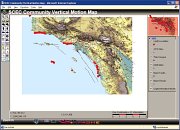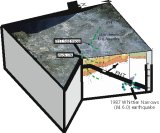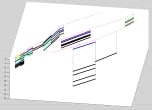Elliot Aguilar
Harvard University |
Mentor: James Evans, Utah State Univ. |
|
Project: Exhumed faults
Project proposals:
a. Analysis of exhumed faults of the San Bernardino Mountains. The current study reveals many more exhumed faults than we can study with a single graduate student. Some of these faults are excellent analogs for buried thrusts of the Los Angeles Basin. 2- 3 weeks of fieldwork would be accompanied by laboratory analyses of faults, either with geochemical and microstructural methods, or through kinematic and mechanical modeling. [Field geology; Structural Geology; Calculus; Geochemistry a plus]. Location: California and Utah.
b. Earthquake and fault energetics. Our database on fault structure is to the point where simple modeling of the amount of energy consumed by heating, fracture energy, etc can be made, and used to examine the relationships between earthquake efficiency and faulting processes. [Physics; Geophysics/Seismology; Structural Geology]. Location: Utah, California.
c. Develop a "Seismologically oriented" field trip guide to important fault localities in the southern California region. This guidebook would summarize bedrock exposures of exhumed faults that are important in conditioning our understanding of faulting and fault structures. [Structural Geology; Geophysics/Seismology; excellent writing library research, and webpage skills.] Location: California.
|
Nicholas Campagna
UCSB |
Mentors: Nathan Niemi and Mike Oskin, UC Santa Barbara |

Project: Geologic Vertical Motion Database
Fact sheet (3.4 MB PDF)
Proposed project: The mentors have a funded grant through SCEC to develop a geologic vertical motion database for southern California funded for this year. Nicholas will help design, develop, and implement a web-served object-relational database for interactively querying and analyzing geologic information on earthquake faults in southern California. The end product will be a database of geologic information on the history of mountain growth and uplift and will provide a resource for earth scientists to explore the vertical motions associated with faulting over the past 100,000 years. The database will be hosted by SCEC for use by the entire earth science community. Specific tasks will include working with geologists to design and develop a functional relational database structure, programming logical relations for database queries for a variety of data types, and developing and producing a web-based graphical user interface for querying the database and returning results. The mentors are committed to having Nicholas interact with SCEC through both the programs designed for the SURE interns, as well as through interactions with other IT and database development groups in southern California that will arise naturally through the course of the summer in the pursuit of this project. |
Jeffrey Hoeft
USC |
Mentor: James Dolan, USC |

Project: Whittier Holocene record
Fact sheet (5.7 MB PDF)
Proposal: One of the legacies of the original SCEC is a rich paleoseismological catalogue of earthquakes in the greater Los Angeles metropolitan region. Presently, there are several large data gaps from this catalogue on some of the more important Los Angeles Basin Faults. Of the faults "missing" fault displacement data, the most significant gap in our current understanding of how strain has been accommodated in the greater Los Angeles Region during the Holocene, is the lack of a record on the Whittier fault beyond 3.5 ka. A trench site has been designated on the Whittier fault, the project has been funded, and work will begin in early June. Jeff will take part in every aspect of the project from the digging of the trench onward. He will aid in mapping the trench, gathering samples for C14 and luminescence dating, and all other aspects of the project. Another part of the project that will be Jeff's responsibility will be photographing the work site, and forming a trench mosaic.
|
Dave Huang,
UC San Diego |
Mentor: Yuri Fialko, U.C. San Diego |
|
Project: Boundary Element (BEM) Solutions
Proposal:
We propose to create a set of rigorously tested finite element and boundary benchmarks that can be used by SCEC's modeling community for code testing and validation. We will also explore to what extent the simpler and computationally more efficient boundary element (BEM) solutions may be used to approximate complex time-dependent problems involving, e.g., visco-elastic relaxation below the brittle-ductile transition. We will work on the development of effective meshing tools for complex fault geometries, and establishment of a high-resolution BEM model for the exploration of mechanical interactions between faults in Southern California as mapped by the SCEC community's fault model. The student will perform numerical modeling of crustal deformation using our existing codes, and analyze the model predictions.
|
Kristen Iriarte,
College of William and Mary |
Mentor: Lisa Grant, UC Irvine |
|
Project: Earthquake-related hazard mitigation
Fact sheet (5.2 MB PowerPoint)
Proposals:
- Orange County GIS Repository of Seismic Hazard Information: Our research shows that seismic hazard information is underutilized at the local planning level, and there are windows of opportunity for input as cities revise their seismic safety elements in the next few years. The goal of this project is to compile a GIS tool for communicating seismic information in Orange County. An undergraduate would assist with data compilation and data entry under the supervision of myself and doctoral student Eric Runnerstrom. The student should have some experience with GIS, especially ArcView.
- Effective seismic risk communication for SCEC target audiences: In 2003 we will attempt to finish this study of how SCEC products are utilized at the local government level for effective seismic risk mitigation. Our study has focused on analyzing the seismic safety element for the general plan of each city in Orange County. An undergraduate intern could assist us with obtaining general plans from city offices, and reviewing the safety elements. Experience with ArcView GIS is desirable, but not required.
- Paleoseismic constraints on earthquake simulations: Lisa Grant is compiling paleoseismic data for input to an earthquake simulation model developed by Steve Ward. Model parameters in the simulation will be adjusted to fit the paleoseismic observations. An undergraduate who is interested in earthquake geology could assist Dr. Grant by reading papers and helping to compile the data. Course work in geology at the upper division undergraduate level should provide adequate preparation.
|
Ryan Tolene
University of Colorado, Boulder |
Mentor: Karl Mueller, University of Colorado |

Project: Coulomb Stress Transfer in Southern California Faults
Fact sheet (40 KB PDF)
Proposal: Ryan's work this summer will be focused on compilation of paleoseismic data in advance of modeling efforts he will undertake as a Masters student starting in 2004. The goal is to determine whether relationships exist between the timing and occurrence of earthquakes on the Eastern California shear zone (ECSZ), southern San Andreas (SAF), San Jacinto (SJF) and Elsinore faults (EF) and to determine, if any relationship exists, whether it can be quantified using Coulomb stress transfer. We seek to extend the record of stress interactions backward in time for these faults by compiling and then using paleoseismic data in our models. Ryan will undertake this compilation with my assistance and that of Tom Rockwell (SDSU). Ryan has already begun this work and has developed an initial paleoseismic inventory for faults in the Eastern California Shear Zone. He will undertake compilation of other paleoseismic data for the San Jacinto, Elsinore and other faults in the Salton Trough this summer.
|
Danielle Verdugo
SDSU |
Mentor: Tom Rockwell, San Diego State Univ. |
|
Project: Hog Lake Rupture Map
Fact sheet (3.4 MB PDF)
Proposal:
Six surface ruptures are now recognized at the Hog Lake paleoseismic site near Anza, California spanning the past 1000 years. Co-seismic slip for discrete events is critical in understanding whether these represent characteristic events for the Anza seismic gap, or whether the Hog Lake site is in an overlap zone with surface ruptures to the north. Daniel Verdugo will work on two tasks related to the Hog Lake site: 1) she will complete a 3D fence-mosaic of all exposures of the site, placing each of the interpreted ruptures into a 3D matrix; and 2) she will work with Jeri Young and Tom Rockwell in developing slip for the past 2-5 events from offset channels in an alluvial fan adjacent to Hog Lake. Work will include hand and backhoe trenches across discrete buried channels adjacent to the narrow main fault zone, and excavation of these channels into the fault to resolve slip. The stratigraphy of the channels, embedded into the fan deposits, will be traced into the pond stratigraphy in which the past six paleoevents are well-recorded.
|
|


